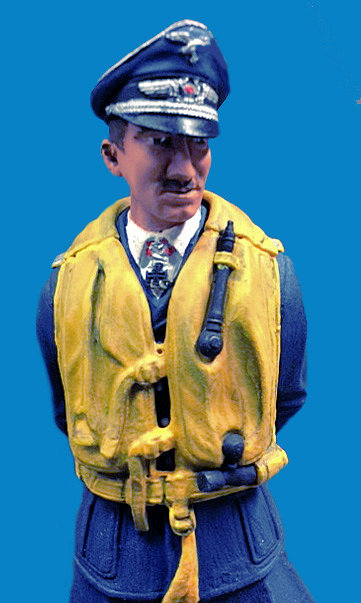 Adolf "Dolfo" Joseph Ferdinand Galland was a German
Luftwaffe general and flying ace that served throughout the Second World War
in Europe. He flew 705 combat missions, and fought on the Western and the
Defense of the Reich fronts. He was shot down four times and survived all
four. During the war, Galland was credited with 104 aerial victories.
Adolf "Dolfo" Joseph Ferdinand Galland was a German
Luftwaffe general and flying ace that served throughout the Second World War
in Europe. He flew 705 combat missions, and fought on the Western and the
Defense of the Reich fronts. He was shot down four times and survived all
four. During the war, Galland was credited with 104 aerial victories.
During the final years of the Weimar Republic, jobs were scarce and life was hard for the Galland family. Adolf had some experience at flying gliders, so he applied to the German Commercial Flying School, which was heavily subsidized by Lufthansa Airlines. He was one of 100 successful applicants out of 4,000. After ten days of evaluations, he was among just 18 selected for flight training. Galland's first flight was in an Albatros L 101. His early career went badly. On one flight, he made a heavy landing and damaged the undercarriage of his aircraft. Later, while leading three aircraft in formation, two of them collided. No one was killed, but Galland was judged to have employed poor formation tactics. These incidents affected him so badly he was convinced he would soon be sent home, and he applied to join the German Army. In the meantime, he carried on with his flight training. Galland did not receive a reply from the Army and settled down to continue his training. He began flying large aircraft weighing over 5,500 lb., and this helped him regain his confidence. The Army accepted his application, but owing to his successful training and improved flying, the flying school refused to release him. By Christmas 1932, he had logged about 150 flying hours.
Early in 1933, Galland was sent to the Baltic Sea training base at Warnemuende to train on flying boats. Galland disliked learning what he perceived to be "seamanship", but logged 25 hours in these aircraft. Later he and several other pilots were ordered to attend an interview at the Central Airline Pilot School (ZVS). Here military personnel in civilian clothing interviewed the group. After being informed that a secret military training program was being established that involved piloting high performance aircraft, all the pilots accepted an invitation to join the organization.
In May 1933, Galland was ordered to a meeting in Berlin as one of 12 civilian pilots among 70 airmen who came from clandestine programs. He met Hermann Göring for the first time at this meeting. Galland was impressed by Göring and believed him to be a competent leader. In July 1933, Galland travelled to Italy to train with the Italian Air Force. At first, the Italians treated the Germans as inferior, but after Galland flew some daring and impressive low-level maneveurs, the German pilots won their hosts' respect.
He returned to the ZVS to learn instrument flying and receive training in piloting heavy transport aircraft. As part of his training, Galland flew Lufthansa airliners. In December 1933, ZVS headquarters recalled Galland and offered him the opportunity to join the new Luftwaffe. Galland found the choice hard as he wanted the adventure of a military flying career, but as an airline pilot, Galland had enjoyed the life style of flying and visiting exotic places and was reluctant to give it up. Nevertheless, he decided to officially join the Luftwaffe.
After basic training in the Army, he was discharged from his barracks in Dresden in October 1934. By February 1935, Galland was part of 900 airmen waiting to be inducted to the new ReichsLuftwaffe. In March Galland was ordered to report to Jagdgeschwader 2 (Fighter Wing 2), arriving at its headquarters in Jüterbog-Damm in April 1935. Galland's performance had not yet been impressive enough for a position as an instructor, so he was evaluated and deemed good enough for an operational posting.
In October 1935, during aerobatic maneveur training, he crashed a Focke-Wulf Fw 44 biplane and was in a coma for three days. He also received other injuries, including a damaged eye, fractured skull and broken nose. When Galland recovered, the doctors declared him unfit for flying. A friend, Major Rheital, kept the doctors report secret to allow Adolf to continue flying. Within a year, Galland showed no signs of injury from his crash. In October 1936 he crashed an Arado Ar 68 and was hospitalized again, aggravating his injured eye. It was at this point that his previous medical report came to light again, and Galland's unfit certificate was discovered. Major Rheital was rumored to have been court-martialed, but the investigators dropped the charges. Galland, however, was grounded. He admitted having fragments of glass in his eye, but convinced the doctors he was fit for flying duty. The doctors ordered Galland to undergo eye tests to validate his claims. Before the testing could begin, one of his brothers managed to acquire the charts. Adolf memorized the charts: he then passed the test and was permitted to fly again.
During the Spanish Civil War, Galland was appointed Staffelkapitän of a Condor Legion unit (J/88) that was sent to support the Nationalist side under Franco at Ferrol from mid-1937. Galland flew ground attack missions in Heinkel He 51s. In Spain, Galland first displayed his unique style: flying in swimming trunks with a cigar between his teeth in an aircraft decorated with a Mickey Mouse figure. When asked why he developed this style, he gave a simple answer: “I like Mickey Mouse. I always have. And I like cigars, but I had to give them up after the war.”
Galland flew his first of 300 combat missions in Spain with the J/88 commander Gotthard Handrick, on 24 July 1937, near Brunete. During his time in Spain, Galland analyzed the engagements, evaluated techniques and devised new ground-attack tactics that were passed on to the Luftwaffe. Ernst Udet, a proponent of the dive bomber and leading supporter of the Junkers Ju 87, used Galland’s experiences in pin-point ground assaults to push for Stuka wings in the Luftwaffe. Wolfram von Richthofen, an opponent of Udet's, used them to push for the opposite: Schlachtflieger dual combination fighter-bombers. After trials with Henschel Hs 123s, Bf 109s and Ju 87s, the Luftwaffe selected the Junkers to undergo trials for the dive bomber role.
On 24 May 1938 Galland left Spain and was replaced by Werner Mölders. Before leaving he made ten flights in the Bf 109, and he was deeply impressed by its performance. This experience persuaded him to change from a strike pilot to a fighter pilot.
From May to August 1938, Galland took leave and visited Spanish Morocco. When he returned to Germany, he was ordered to the headquarters of the Reichsluftfahrtministerium (RLM—Ministry of Aviation) where he was tasked with preparing recommendations on close air support tactics. Galland favored the virtually simultaneous attack of the air force before the Army advance, leaving their opponents no time to recover. While this reasserted the lessons of World War I, some officers were still pessimistic as to whether that kind of coordination was possible. Galland also adopted the Italian suggestion of heavy armament and criticized the light machine guns in early German fighter aircraft and pointed to the advantages of multi-gun configurations (i.e., combining machine guns with cannons). These proved successful in the Bf 109 and Focke-Wulf Fw 190.
Galland also recognized the ability of drop tanks to extend the range of aircraft as well as the need for specialized tactics to escort bomber fleets; for example, Galland did not subscribe to the prevailing idea in the Luftwaffe (and RAF) that the bomber "would always get through" by itself. The RLM adopted all of Galland's suggestions on tactics, and they proved successful in the early campaigns of World War II (1939–41). During his time in the RLM, he instructed, trained and equipped ground-support wings for Case Green, the planned 1938 invasion of Czechoslovakia. However, the invasion never happened
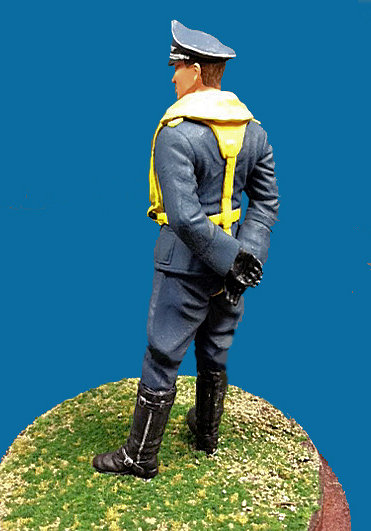 Just before the outbreak of war, Galland was promoted
to captain. During the September 1939 invasion of Poland, Galland flew the
Henschel Hs 123, nicknamed the "biplane Stuka," supporting the German Tenth
Army. On 1 September, Galland flew alone in a Fiesler Fi 156 'Storch' on a
reconnaissance mission and was nearly shot down. The next day he flew ground
attack missions in support of the 1st Panzer Division advancing to the Warta
River. During this campaign, the Luftwaffe had been executing the kind of
close air support operations Galland had been advocating. Galland flew 87
missions in the Poland campaign. After flying nearly 360 missions in two
wars and averaging two missions per day, on 13 September 1939, Galland was
awarded the Iron Cross Second Class.
Just before the outbreak of war, Galland was promoted
to captain. During the September 1939 invasion of Poland, Galland flew the
Henschel Hs 123, nicknamed the "biplane Stuka," supporting the German Tenth
Army. On 1 September, Galland flew alone in a Fiesler Fi 156 'Storch' on a
reconnaissance mission and was nearly shot down. The next day he flew ground
attack missions in support of the 1st Panzer Division advancing to the Warta
River. During this campaign, the Luftwaffe had been executing the kind of
close air support operations Galland had been advocating. Galland flew 87
missions in the Poland campaign. After flying nearly 360 missions in two
wars and averaging two missions per day, on 13 September 1939, Galland was
awarded the Iron Cross Second Class.
After the Polish Campaign, Galland claimed to be suffering from rheumatism and therefore unfit for flying in open-cockpit aircraft, such as the Hs 123. He tactfully suggested that a transfer to a single-engine aircraft type with a closed cockpit would improve his condition. His request was accepted on medical grounds, and Galland was removed from his post as a direct ground support pilot. He was then transferred to a fighter wing (JG 27).
On 10 May 1940, the Wehrmacht invaded the Low Countries and France. JG 27 supported German forces in the Battle for Belgium. On the third day of the offensive, 12 May 1940, while flying a Messerschmitt Bf 109, Galland claimed his first aerial victories over two RAF Hawker Hurricanes.
Galland claimed his third Hurricane later that same day over Tienen. He had long believed that his opponents had been Belgian, not knowing that all of the Belgian Air Force's Hurricanes had been destroyed on the ground in the first two days, without seeing combat. On 19 May, Galland shot down a French Potez aircraft. During this flight he ran out of fuel short of the runway and landed nearby, at the base of a hill. With the help of soldiers from a German Flak battery, he pushed the Bf 109 up the hill and then half-flew, half-glided down to the Charleville-Mézières airfield in the valley below. He sent back a can of fuel for his wingman, who had also landed short of the runway. He continued flying and the next day, claimed another three more aircraft, making a total of seven. On 22 May Galland was awarded the Iron Cross First Class.
From June 1940 on, Galland commanded JG 26, fighting in the Battle of Britain with Messerschmitt Bf 109Es. On 19 July 1940, he was promoted to Major and JG 26 moved to the Pas de Calais, where they were to remain for the next 18 months.
On 24 July 1940, almost 40 JG 26 Bf 109s took off for operations over the English Channel, where they were met by 12 Spitfires. The Spitfires forced the larger number of Bf 109s into a turning battle that ran down the Germans' fuel. Galland recalled being impressed by the Spitfire's ability to out-maneveur Bf 109s at low speed and to turn into the Bf 109s within little airspace. Only by executing a "Split S" (a half-roll onto his back, followed by pulling into a long, curving dive) that the Spitfire could not follow without exceeding its maximum safe speed and risking structural failure, could his aircraft escape back to France at low altitude. Galland’s swarm of fighters covered their retreat, losing two Bf 109s to Spitfires. During the action, two Spitfires were shot down with the loss of four Bf 109s. Galland was shocked by the aggression shown by pilots he believed to be relatively inexperienced. Galland later said he realized there would be no quick and easy victory.
By 15 August, in two weeks fighting over Britain, Galland had increased his aerial victories to 22. On this day he claimed three Spitfires. This put him to within three victories of Mölders, who had claimed the highest number of enemy aircraft destroyed and who was wounded and grounded with a damaged knee.
Galland was summoned to a meeting with Göring on 18 August 1940, and missed the intense air battle that day, known as The Hardest Day. During the meeting, Göring insisted that, in combat, Bf 109 fighters escort Bf 110s, which could not survive against single-engine fighters. As high-scoring aces, both Galland and Mölders shared their concerns that close escort of Bf 110s and bombers robbed fighter pilots of their freedom to roam and engage the enemy on their own terms. They also pointed to the fact that German bombers flew at medium altitudes and low speed, the best height area and speed for the RAF’s Spitfire. Galland resented his pilots having to carry out a task unsuited to their equipment, but Göring would not move from his position.
During the battle, Göring criticized the fighter pilots for the growing bomber losses. In a front line general officer briefing on Luftwaffe tactics, Göring asked what his fighter pilots needed to win the battle. Werner Mölders replied that he would like the Bf 109 to be fitted with more powerful engines. Galland replied: "I should like an outfit of Spitfires for my squadron," which enraged Göring. Galland still preferred the Bf 109 for offensive sweeps, but he perceived the Spitfire to be a better defensive fighter because of its maneuverability. On 5 December 1940, Galland recorded his 57th victory. This made him the most successful fighter pilot of the war at that point, putting him ahead of his colleague, friend and rival Werner Mölders.
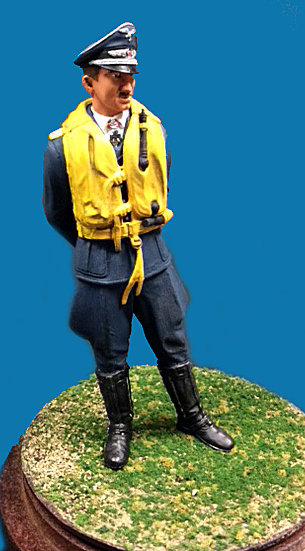 Galland
continued to lead JG 26 in 1941 against the RAF fighter sweeps across
northern Europe. In early 1941, most of the Luftwaffe's
fighter units were sent to the Eastern Front, or south to the Mediterranean
Theater of Operations, leaving only JG 26 and JG 2 as the sole single-engine
fighter units in France. By this
time, JG 26 were being re-equipped with the new Bf 109F, normally equipped
with a 15 mm (or later a 20 mm) cannon firing through the propeller hub and
two cowl-mounted 7.9 mm MG 17s. Galland felt the model was grossly
under-armed and so tested a series of 109 "specials" – one with a unique
armament of an MG 151/20 cannon and two cowl-mounted 13 mm MG 131 machine
guns, and another with integral wing-mounted 20 mm MG FF cannons.
Galland
continued to lead JG 26 in 1941 against the RAF fighter sweeps across
northern Europe. In early 1941, most of the Luftwaffe's
fighter units were sent to the Eastern Front, or south to the Mediterranean
Theater of Operations, leaving only JG 26 and JG 2 as the sole single-engine
fighter units in France. By this
time, JG 26 were being re-equipped with the new Bf 109F, normally equipped
with a 15 mm (or later a 20 mm) cannon firing through the propeller hub and
two cowl-mounted 7.9 mm MG 17s. Galland felt the model was grossly
under-armed and so tested a series of 109 "specials" – one with a unique
armament of an MG 151/20 cannon and two cowl-mounted 13 mm MG 131 machine
guns, and another with integral wing-mounted 20 mm MG FF cannons.
On 10 May 1941, Galland received a telephone call from Göring requesting Galland intercept a Messerschmitt Bf 110 flown by Rudolf Hess heading for Scotland. Galland was unable to launch a full fighter sweep. However, Hess' flight was far to the north and he reached Scotland where he crashed his aircraft. Galland sent out fighters to conduct some sweeps so he could honestly claim to have carried out his orders but it was nearly dark and Galland ordered his pilots, who were not use to night flying, to stand down.
Galland continued his successes in the summer. On the morning of 21 June, he accounted for two Bristol Blenheims but was shot down by the Spitfire escorts, crash-landing near Calais. That same afternoon, Galland shot down a Spitfire, but watching his victim for too long, he himself was shot down by another Spitfire. Galland bailed out and tugged at what he thought was his parachute ripcord, but was actually pulling at his parachute release harness. With a "sickening" feeling, he composed himself and pulled the ripcord, which then opened his chute. Theo Osterkamp drove over to the hospital where Galland was being treated for his wounds and informed him his 69 victories had now earned him the Knight's Cross of the Iron Cross with Oak Leaves and Swords.
On 2 July 1941, Galland led JG 26 into combat against a formation of Blenheim bombers. Galland's fighter was hit by a 20 mm round from one of the bombers’ escort fighters. The armor plate fitted to the Bf 109 just days earlier saved Galland's life. Wounded in the head, he managed to land and was again hospitalized for the second time in a few days. Just earlier that week, when the armor plate was installed, he severely berated his mechanic, Gerhard Meyer, who welded it in, when he hit his head on the canopy upon entering his aircraft. That same mechanic received "a grateful slap on the back". Galland had been shot up and shot down twice in the space of four days. The Blenheim kill brought his tally to 70.
Throughout the summer, Galland claimed another 14 Spitfires in battles against Fighter Command over France. On 23 July 1941, he accounted for three Spitfires (kills 71–73)—one in the afternoon and two in the evening. He scored another two on 7 August to reach 75 aerial victories. On 19 August, he claimed two Spitfires and one Hurricane to surpass the World War I ace Manfred von Richthofen's tally of 80. Galland also flew the Focke-Wulf Fw 190 in autumn 1941 when his unit converted to the type, though he retained and flew Bf 109s himself. On 21 October he shot down three more Spitfires to reach 92 kills. His 96th victim—yet another Spitfire—was claimed on 18 November 1941. It proved to be his last official victory for three years as he was about to be forbidden to fly combat missions.
In November 1941, he was chosen by Göring to command Germany's fighter force as General der Jagdflieger, succeeding Werner Mölders, who had just been killed in an air crash en route to attend the funeral of Ernst Udet. Galland was not enthusiastic about his promotion, seeing himself as a combat leader and not wanting to be "tied to a desk job". Soon afterward, on 28 January 1942, Galland was awarded the Knight's Cross of the Iron Cross with Oak Leaves, Swords and Diamonds for his service as the commander of JG 26.
A strong proponent of the day fighter force and the defense of Germany, Galland used his position to improve the position of the Jagdwaffe. Germany had declared war on the United States on 11 December 1941, and Galland was keen to build up a force that could withstand the resurgence of the Western Allied Air Forces in preparation for what would become known as the Defense of the Reich campaign. Galland was outspoken, something that Göring often did not tolerate. In spite of this, Galland was able to survive in his position for three years.
After his appointment, Galland was strictly confined to operational matters and not allowed to fly tactical or combat missions. As the war continued Galland flew missions in violation of these restrictions against the US Army Air Forces (USAAF) bombing raids against Germany. Galland familiarized himself with all types of German fighter aircraft and flew the Fw 190 on these intercept missions. He would actively engage American bombers on some raids. On at least one mission, he shot down a USAAF heavy bomber, and it is possible that he shot down as many as three USAAF heavy bombers while flying Fw 190s.
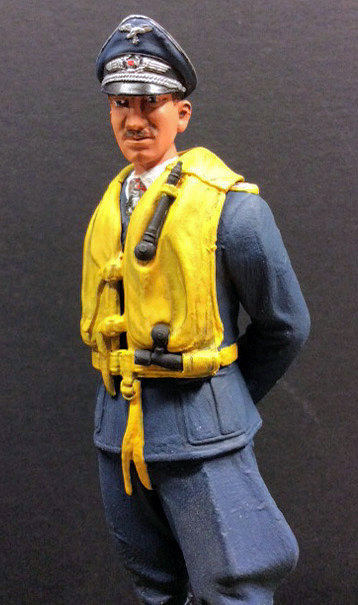 As the war
continued, Galland’s increasingly was at odds with Göring. In 1942–44, the
German fighter forces on all fronts in the European Theatre of Operations
(ETO) came under increasing pressure and Galland's relationship with Göring
began to sour. In the spring of 1943, Galland suggested that the fighter
forces defending Germany should limit the number of interceptions flown to
allow sufficient time for re-grouping and to conserve air strength. Only by
conserving its strength and its precious resources—the fighter pilots—could
the Luftwaffe hope to inflict
damage on the bombers. Göring refused, and he demanded every raid be
countered in maximum strength regardless of the size of the Allied fighter
escort.
As the war
continued, Galland’s increasingly was at odds with Göring. In 1942–44, the
German fighter forces on all fronts in the European Theatre of Operations
(ETO) came under increasing pressure and Galland's relationship with Göring
began to sour. In the spring of 1943, Galland suggested that the fighter
forces defending Germany should limit the number of interceptions flown to
allow sufficient time for re-grouping and to conserve air strength. Only by
conserving its strength and its precious resources—the fighter pilots—could
the Luftwaffe hope to inflict
damage on the bombers. Göring refused, and he demanded every raid be
countered in maximum strength regardless of the size of the Allied fighter
escort.
During the late summer of 1943, USAAF fighters operated over German air space for the first time. Several aircraft crashed near Aachen on the cusp of Germany's west border. Galland presented these wrecks as proof that the Luftwaffe was facing an enemy that could soon escort its heavy bombers with fighter aircraft to industrial targets inside Germany. Galland submitted his findings to Göring. Göring was livid. The Reichsmarschall called the report the "rantings of a worn-out defeatist", and ordered that no Allied fighters had crossed into Germany. Göring declared the only possible reason could have been that short-range fighters ran out of fuel at high altitude and "they were shot down much further west... and glided quite a distance before they crashed. Galland denied this, and questioned why an Allied pilot would choose to glide east instead of west. He further argued that Germany must immediately increase fighter production to reach a three or fourfold advantage over the attackers to meet this new threat. Galland's efforts to produce a fighter force fit for a war of attrition conflicted with Göring's bias in favor of bombers to maintain the offensive on all fronts. It was a policy the Reichsmarschall persisted with until the autumn of 1943.
In October 1943, the fractious relationship came to the surface again. Galland met with Göring at Göring's estate, Schloss Veldenstein. During the conversation the need for new and improved interceptor aircraft arose. The demands made by Göring, that heavily cannon-armed fighters be used in mass numbers to defeat bomber formations, were unreasonable to Galland. Göring, prompted by Hitler, wanted aircraft armed with heavy cannons that fired at a rate of one shell per second. Galland explained that such a weapon could not be used effectively in an aircraft; the cannon would be prone to jamming and the aircraft would be too difficult to manuveur. Galland also asserted the use of inappropriate weaponry such as the Messerschmitt Me 410, a favourite of Hitler's, had caused heavy losses. Göring ignored Galland's arguments and continued his frequent attacks on the fighter force, accusing them of cowardice. Galland, as he always did, defended them, risking his career, and near the end of the war, his life in doing so. Galland stated that he could not agree to follow Göring's plans and requested to be dismissed from his post and sent back to his unit. Göring accepted, but two weeks later he apologized to Galland and attributed his behaviour to stress. Galland thus continued in his post.
To improve things for the fighter force, Galland looked to employ new technology in the air war. On 23 May 1943, Galland flew an early prototype of the Messerschmitt Me 262 jet fighter. Galland became an enthusiastic supporter of the aircraft, realizing its potential as a fighter rather than a bomber. Galland hoped that the Me 262 would compensate for the numerical superiority of the Allies.
Galland succeeded in temporarily persuading Milch to support cancelling the Me 209 program in favor of producing 100 Me 262s by the end of 1943. However, because of persistent problems with its turbojet engines and later, Hitler's determination to use it as a bomber, the Me 262 was not developed as a fighter until late in the war.
By spring 1944, the Me 262 was sufficiently ready for operational service. By this time, Galland faced several rivalries within the Luftwaffe over how best to employ the aircraft. Dietrich Peltz, commander of the 9th Air Corps, wanted to use the aircraft as a weapon against a future Allied landing in France. Peltz saw the aircraft as an ideal fast bomber that could evade the overwhelming numbers of Allied piston-engine fighters and attack the landing sites. Peltz also wanted to use highly trained bomber pilots whom he felt could better serve as home defense fighter pilots. In Peltz’ view, their instrument flying experience and training and background in multi-engine aircraft made them ideal for these operations. In the first five months of 1944, Peltz' conventional bomber force had suffered a significant defeat over England, but that did not dampen his appetite for offensive action or dent his reputation with Göring. Galland argued against his suggestion. Instead, Galland thought the bomber corps should be disbanded and its pilots converted into fighters. Göring ultimately adopted Peltz' idea to impress Hitler and regain his waning influence.
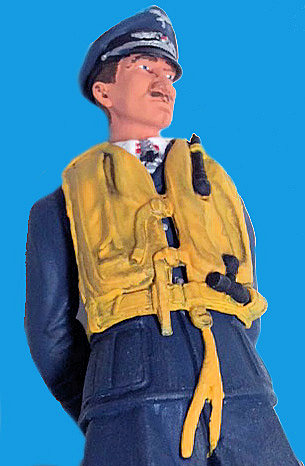 Although they had low serviceability rates, the
all-jet units achieved considerable success. To see how new aircraft
performed in action, Galland often visited the front line airfields close to
the scene of the fighting. On 8 November 1944, he was present when ace
Walter Nowotny took off with a force of Me 262s in an overcast to engage a
USAAF raid. Galland listened to it over the radio. Nowotny claimed a bomber
but his Me 262 was damaged. He was then jumped by USAAF fighters and crashed
close to the airfield. Galland heard the firing but did not see the event.
It did not, however, dissuade him from believing in the capabilities of the
aircraft as a fighter.
Although they had low serviceability rates, the
all-jet units achieved considerable success. To see how new aircraft
performed in action, Galland often visited the front line airfields close to
the scene of the fighting. On 8 November 1944, he was present when ace
Walter Nowotny took off with a force of Me 262s in an overcast to engage a
USAAF raid. Galland listened to it over the radio. Nowotny claimed a bomber
but his Me 262 was damaged. He was then jumped by USAAF fighters and crashed
close to the airfield. Galland heard the firing but did not see the event.
It did not, however, dissuade him from believing in the capabilities of the
aircraft as a fighter.
Galland also pursued innovations on existing designs. The Focke-Wulf Fw 190 aircraft was formed into several groups with distinctly upgraded firepower. Called the Sturmbock (Battering ram), these machines could inflict heavy damage on unescorted bomber formations. The Sturmbock were heavily armed and armored, which meant they were un-maneuverable and vulnerable without protection from escorting Bf 109s. Still, the tactics quickly became widespread and were one of the few Luftwaffe success stories in 1944. Galland said after the war, that had it not been for the Allied landing in Normandy that increased the need for lighter fighter variants, each Geschwader in the Luftwaffe would have contained a section of Sturmbock aircraft by September 1944.
Galland himself flew on unauthorized intercept flights to experience the combat pressures of the pilots, and witnessed USAAF bombers being escorted by large numbers of P-51 Mustangs. Nevertheless, on occasions the Sturmbock tactics worked. For example, on 7 July 1944 unescorted Eighth Air Force bombers belonging to the 492nd Bomb Group were intercepted. The Luftwaffe shot down the entire squadron of 12 B-24s. The USAAF 2nd Air Division lost 28 Liberators that day, the majority to a Sturmbock attack.
Despite Göring's apology after their previous dispute, the relationship between the two men did not improve. Göring's influence was in decline by late 1944 and he had fallen out of favor with Hitler. Göring became increasingly hostile to Galland, blaming him and the fighter pilots for his situation. In 1944, things worsened. A series of USAAF raids termed Big Week won air superiority for the Allies in February. By the spring of 1944, the Luftwaffe could not effectively challenge the Allies over France or the Low Countries. Operation Overlord, the Allied invasion of German-occupied Europe, took place in June 1944. According to a report made by Galland, in the previous four months 1,000 pilots had been killed. Galland reported that the enemy outnumbered his fighters between 6 and 8 to 1, and the standard of Allied fighter pilot training was "astonishingly high".
On 17 January,
a group of senior pilots took part in a "Fighter Pilots Revolt". Galland's
high standing with his fighter pilot peers led to a group of the most
decorated Luftwaffe combat leaders loyal to Galland (including Johannes
Steinhoff and Günther Lützow) confronting Göring with a list of demands for
the survival of their service. Göring initially suspected Galland had
instigated the unrest. Heinrich Himmler had wanted to put Galland on trial
for treason himself; the SS and Gestapo had already begun investigations
into who his associates were. The Oberkommando der
Luftwaffe (OKL) appointed the more politically
acceptable Gollob, a National Socialist supporter, to succeed Galland on 23
January. Although professional contemporaries, Gollob and Galland had a
mutual dislike, and after Galland had removed the Austrian from his personal
staff in September 1944, Gollob started to gather evidence to use against
Galland, detailing false accusations of his gambling, womanizing, and
alleged private use of Luftwaffe transport aircraft. The official reason for
his being relieved of command was his “ill health.”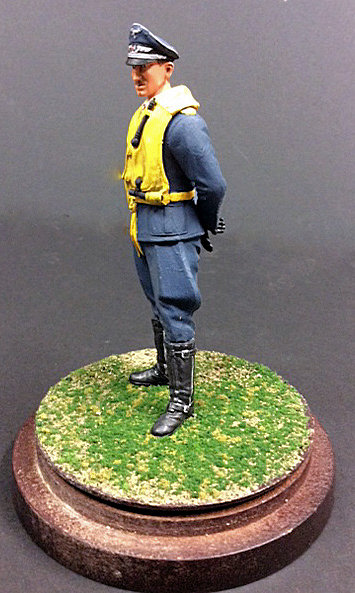
For his own safety, Galland went to a retreat in the Harz Mountains. He was to keep the RLM informed of his whereabouts, but was effectively under house arrest. Hitler, who liked Galland, had not heard of the events. However, when he learned of them he ordered that the nonsensical treatment of Galland was to stop immediately. Hitler had been informed by Albert Speer, who in turn had been informed of events by one of Galland's close friends. In the end, Göring contacted Galland and invited him to Karinhall. In light of his service to the fighter arm, he promised no further action would be taken against him and offered him command of a unit of Me 262 jets. Galland accepted on the understanding that Gollob had no jurisdiction over him or his unit.
Galland was initially assigned to command a Staffel of Jagdgeschwader 54, at that time stranded behind Soviet lines in the Courland Pocket. Galland never took over this command but was given the task of forming JV 44.
Galland was allowed to hand pick a number of experienced fighter pilots and aces for the unit, including Johannes Steinhoff, Erich Hohagen, Heinrich Bär and Gerhard Barkhorn. Erich Hartmann was also asked but would not leave his unit. The unit was officially formed on 22 February 1945. Galland did everything he could to introduce the Me 262s to the wing as quickly as possible. Göring showed sympathy for Galland's efforts, which thus far had only 16 operational jets in February. General Josef Kammhuber was asked to assist Galland. Bomber Wings 51, 6 and 27 were behind on their training schedules for jets, and they were to hand over their pilots and Me 262s to Jagdgeschwader 7 and Kampfgeschwader 54. Galland suggested that all experienced fighter pilots flying with Bf 109 or Fw 190 units should also join the Me 262 unit. If this could be done Galland believed he could get 150 jets in action against the USAAF fleets. The general chaos and the impending collapse of Germany prevented his plans from being realized.
In the space of six days, Galland's friend Steinhoff was badly burned in a crash on 18 April, and then, on 24 April, his friend Lützow was posted as missing in action. On 21 April, Galland was credited with his 100th aerial victory. He was the 103rd and last Luftwaffe pilot to achieve the century mark. On 26 April, Galland claimed his 103rd and 104th aerial victories against B-26s. Galland again made a mistake; he stopped to make sure his second victory was going to crash and he was hit by a USAAF P-47 Thunderbolt piloted by James Finnegan. Galland nursed his crippled Me 262 to the airfield, only to find it was under attack by more P-47s. Galland landed under fire and abandoned his jet on the runway. The battle was his last operational mission. Soon afterward, he was sent to hospital for a knee wound sustained during his last mission.The Americans lost four B-26s and another six damaged. In return two Me 262s were shot down with the other Me 262 pilot surviving.
By late April, the war was effectively over. At the
time of his surrender, Galland had filed claims for 104 Allied aircraft shot
down. His claims included seven with the Me 262.
Galland was eventually released on 28 April 1947.
After his release, he travelled to Schleswig-Holstein to join Baroness
Gisela von Donner, an earlier acquaintance, on her estate and lived with her
three children. During this time, Galland found work as a forestry worker.
There he convalesced and came to terms with his career and alleged knowledge
of Nazi war crimes. Soon Galland rediscovered his love of flying. Kurt Tank,
the designer of the Fw 190,
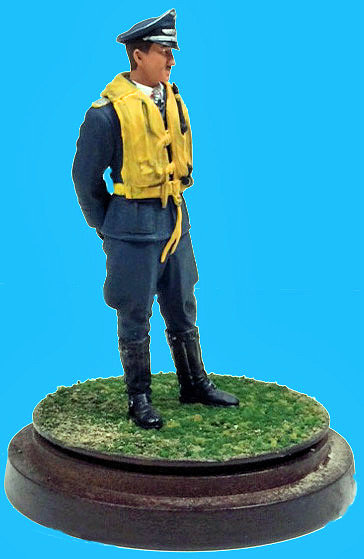 requested that he go to his home in Minden to
discuss a proposal. Tank had been asked to work for the British and Soviets,
and had narrowly avoided being forcibly kidnapped by the latter. Tank,
through a contact in Denmark, informed Galland about the possibility of the
Argentine Government employing him as a test pilot for Tank’s new fighter
generation. Galland accepted and flew to Argentina. He settled with Gisela
in El Palomar, Buenos Aires. Galland enjoyed the slower life. Aside from
work commitments, his time there was taken up with Gisela and the active
Buenos Aires night life. Galland found South America a world away from the
post-war shortages in Germany. Soon, he took up gliding again.
requested that he go to his home in Minden to
discuss a proposal. Tank had been asked to work for the British and Soviets,
and had narrowly avoided being forcibly kidnapped by the latter. Tank,
through a contact in Denmark, informed Galland about the possibility of the
Argentine Government employing him as a test pilot for Tank’s new fighter
generation. Galland accepted and flew to Argentina. He settled with Gisela
in El Palomar, Buenos Aires. Galland enjoyed the slower life. Aside from
work commitments, his time there was taken up with Gisela and the active
Buenos Aires night life. Galland found South America a world away from the
post-war shortages in Germany. Soon, he took up gliding again.
For his services in Argentina, Galland received a pilot's wings badge and the title Honorary Argentine Military Pilot. Later that year, Galland left South America. He published his memoirs in 1954, and it was a best-seller in 14 languages and sold three million copies.
In the summer of 1957, Galland moved to Bonn and rented an office on Koblenzerstrasse, beginning his own aircraft consultancy there. Galland worked hard but continued flying, taking part in national air shows. In 1956, he was appointed honorary chairman of the Gemeinschaft der Jagdflieger, the Association of Fighter Pilots. Through this, he came into contact with contemporaries in Britain and America. In 1961, he joined the Gerling Group of Cologne who contracted Galland to help develop their aviation business. With business going well, Galland bought his own aircraft on 19 March 1962, his 50th birthday. The aircraft was a Beechcraft Bonanza, registered D-EHEX, which he named Die Dicke (Fatty).
In 1969, he served as technical adviser for the film Battle of Britain, in which the character Major Falke is based on Galland. Galland was upset about the director's decision not to use the real names. While making the film, Galland was joined by his friend Robert Stanford Tuck. In 1973, Galland appeared in the British television documentary series The World at War.
Galland took part in many engagements throughout the 1960s and 1970s. In 1974, he was part of the remaining German General Staff that took part in the Operation Sea Lion wargame at Sandhurst in the United Kingdom, replicating the planned German invasion of Britain in 1940. In 1975, he was a guest at the RAF Museum Hendon, during the unveiling of the Battle of Britain Hall, where he was entertained by Prince Charles. In 1980, Galland's eyesight became too poor for him to fly and he retired as a pilot. However, he continued to attend numerous aviation events, to include being a periodic guest of the US Air Force for their annual "Gathering of Eagles" program at the Air Command and Staff College at Maxwell AFB, Alabama. Galland had located them before and had tried to buy them back, only to be told no, as they would be worth more after his death. Towards the end of the 1980s, Galland's health began to fail. Adolf Galland died in February 1996.
| THE KIT |
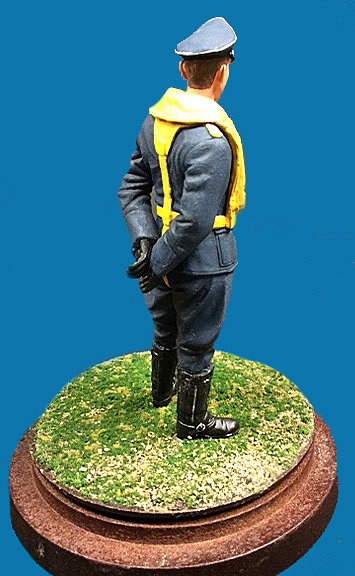 block and inserted the other ends of the paper clips into the holes. I used
white glue to temporarily secure the figure to the wooden base so I could handle
it while painting it. When this was dry, I prepped the figure with Testors flat
white enamel shot through my Paasche airbrush to serve as the base coat and
provide a light base for subsequent hand painting with a combination of acrylics
and enamels.
block and inserted the other ends of the paper clips into the holes. I used
white glue to temporarily secure the figure to the wooden base so I could handle
it while painting it. When this was dry, I prepped the figure with Testors flat
white enamel shot through my Paasche airbrush to serve as the base coat and
provide a light base for subsequent hand painting with a combination of acrylics
and enamels.